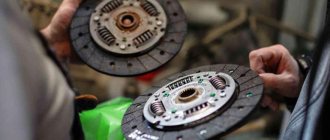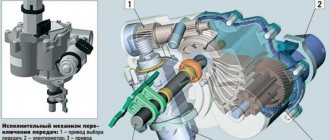Lada Vesta is the first Russian car that can be considered a foreign car. There was a powerful PR about him, which gave the first impetus. When sales began in November 2015, 1,700 cars sold out. Then harsh economic reality set in. It was planned to sell about 5,000 cars in December, but in practice we bought half as many. Those buying sentiments that are present do not allow us to seriously hope that the picture will somehow change.
The first thing that always comes to mind when talking about budget cars of this kind is savings. When creating such a car, the manufacturer always saves on everything. If you save a dollar on a car, it doesn't seem like much. But when a car is produced in an edition of 50,000 copies, that’s already a sum. If you saved two dollars, then that's already a good amount. And if 50 dollars is a lot of money. Today we’ll look at what kind of car the Lada Vesta with the AMT robot is and whether it’s worth buying.
Vehicle inspection
It all starts in the little things. We approach the car from behind and try to open the trunk. At first it doesn’t work because there is no open button. What you need to do to do this is press the button on the key fob. After a few seconds everything worked. Let's go further and look into the trunk, it's quite decent. There are hinges, which are also found on all budget sedans. Secondly, the upholstery is made of something unknown. There is plenty of legroom in the rear seats and the car is spacious.
As for the Lada Vesta engine. If it had not had a VAZ engine, the car could have been much more expensive. It's the same story with the gearbox. There are manual transmissions; they don’t make automatic transmissions in Russia. Therefore, we decided to take a classic VAZ gearbox and attach attached electronics to it, control systems that can be purchased, and get our own gearbox. And so they did. The node that stands is called the AMT robot. In essence, it is a five-speed VAZ manual with additional equipment. That's why the car only has two pedals.
Owner reviews about Vesta Cross with AMT
“I was able to try out the new Lada Vesta literally a few days after the official presentation: fortunately, a friend working in the salon helped. In terms of handling, the car behaves like a regular sedan, I didn’t notice any special dynamics, apparently, it was cut off by the AMT gearbox. I can say the following about the box itself: if you don’t pull the gas pedal, the robot does its job very well. I would like to try the version of the car with a turbocharged engine.”
(Evgeniy, Moscow)
“Initial reviews of the new Lada Vesta Cross model excited me and aroused very strong interest. I immediately signed up for a test drive, which I was very lucky with - it was a day off and the roads were clear. Having accelerated to 90 km/h, I noticed the first drawback: the noise insulation leaves much to be desired; if you exceed the barrier of 90, you can feel like a pilot of a Soviet transport aircraft - the hum is like during takeoff.
The handbrake position is not very convenient, it is placed almost close to the armrest, it is very inconvenient to use - I don’t understand how the inspection commission missed it. However, I got a car literally 3 months after the test drive. Already during operation, I noticed jerks when driving around the city, but this is more likely due to my driving style.”
(Alexander, Vladimir)
“I am the owner of Vesta Cross with an AMT robot. I'll start with what I liked most:
- quality of plastic in the cabin;
- appearance of the car;
- body kits are installed perfectly - no cracks or gaps;
- functional adjustment of the steering wheel and seats.
Of the minuses, I can note the following:
- small trunk capacity, you often have to fold the rear seats;
- There are problems with the spaciousness of the interior; with average dimensions and a height of 185 cm, I felt a little cramped at first.
Otherwise, the car performed excellently, both in the city and on numerous trips out of town.”
(Kirill, Nizhnekamsk)
“I bought the Cross version to replace the previous version (from 1.6). I didn’t notice any particular differences in the comfort and general parameters of the car, but the driving style had to be slightly adjusted. I was again pleased with the reduced consumption; I still haven’t found an answer to the question of what is the secret of such a difference. Unfortunately, the oil intake has not really disappeared, except that according to my own observations, it has become significantly less wasted. I’m very pleased with the car, and I feel that it will be difficult to switch to something else now.”
(Vsevolod, Yekaterinburg)
What is an AMT robot?
This is an ordinary VAZ five-speed manual transmission, to which electronics and control mechanisms purchased by ZTF were screwed. Vesta AMT robot is a mechanic that switches without outside help, and does it in a unique way. There are two modes of switching mode: automatic and manual. Let's switch to manual mode and accelerate. The robot holds first gear and does not shift to second.
Manually switch to second speed and accelerate further. He has already moved to the third one himself. Switching to the next gears also occurs automatically. It doesn't shift too quickly, since the clutch is open for about 1 second. All switching turns out to be long, you have to come to terms with this. It’s better to buy a car with a manual transmission; a robot is a strange thing here. The only reason a robotic gearbox is used here is to carve. The price of imported automatic transmissions has now jumped up significantly.
Comments by Vladimir Petunin
It all started with an interview given to the Za Rulem publication by Vladimir Petunin, who, in fact, heads the AMT project.
He noted that the robotic transmission was created with the support of German companies. In this case, the main partner was ZF, while Porsche Engineering was a co-partner. In particular, Porsche Engineering was responsible for the basic tuning of the AMT.
After that, 4 years have passed, during which AvtoVAZ representatives closely monitored the operation of the gearbox, and special attention was paid specifically to complaints from owners of cars equipped with such a gearbox.
And so, having accumulated the required amount of data, AvtoVAZ modernized the transmission, and the lion's share of the adjustments falls on the unit control program.
Appearance
In general, the Lada Vesta is a decent car, but there are some problems. If the weather had been sunny now, we would not have seen anything on the instruments. Everything is glare, the numbers are not visible, there is no brightness adjustment. There is a trip computer, which is quite decent. Its numbers are visible in any light. Then things start to get weird again. The windshield is heated - you can see the threads that are built into it and should warm the glass.
Front and rear heating is turned on with one button. But for some reason the front one takes a long time to warm up, it’s easier to clean the glass yourself. There is no heated steering wheel, although we have a cold climate. But the heated seats provide good warmth. If you compare it with Mazda, it has heating with three positions, everything is done in a complex, modern way. You turn it on and wait a long time before it starts to heat up. After half a minute it becomes warm, and after two minutes you already want to turn it off.
Real opinions of owners
Among the reviews from owners about the Lada Vesta robot in 2022, you can find negative opinions: never again! Where does such categoricalness come from? And are there opinions opposite to this? It all depends on your expectations. You shouldn’t demand the impossible from the Lada: at that price, it’s clear to everyone that the car won’t be equipped with a fast automatic transmission. If we perceive the robot on the Lada as the first steps in this direction by a domestic manufacturer, then the AMT will be looked at in a different light.
Multimedia system
Another thing that cannot be ignored is the local multimedia system. In this case, we have a color screen, a touchscreen, and a sophisticated entertainment system, which is offered only in the most expensive versions. Let's try to test it. We grabbed a flash drive with music and video files. The performance of such systems is simply determined. She reads everything she is asked to read.
Read: Lada Vesta radio without a screen.
There is also navigation - a strange thing with maps. As for our Russian localities, the map knows almost nothing about them. But, at the same time, there is a detailed map of Italy. This is a mockery of the potential owner of Vesta, who only knows about Italy from TV! This is a consequence of a difficult fate. Therefore, it is better to remain silent about navigation.
Shift speed
AMT 2.0 has become significantly faster than its predecessor. Thanks to the use of advanced algorithms, even an inexperienced driver will be able to feel the difference. The new gearbox now reacts 30% faster to changes in engine speed and selects the desired gear. Improvements are felt both when accelerating and when decelerating the car.
Of course, there is no need to talk about smooth and imperceptible gear shifting yet. The driver and passengers feel jerks when the gearbox operates, but there are no such deep dips as in the previous firmware version. Due to more correct switching, fuel consumption has decreased, which cannot but please owners of a budget car.
Price
How much does Lada Vesta cost? We were once told that a Lada Vesta with an AMT robot would cost 400 thousand rubles. After the Ukrainian-Crimean history, it quickly became clear that for a variety of reasons it would not be worth 400 thousand. The question is - how much? For a long time there was a glimmer of hope that at least the price of admission to the “news guides” club would remain at the level of 500 thousand or less, and would not cross this psychological barrier. It didn't work out that way. Already now the cheapest Vesta costs more than 600 thousand, but this is a spherical place in a vacuum.
The most expensive Vesta is about 900 thousand. Thanks to powerful PR support for entering the market, VAZ managed to sell several tens of thousands of cars. This could be taken as a great success. Problems started later and sales fell. This is a problem because there is nothing in sight that could improve the situation. What's the point of advertising a product to people if they don't have money to buy it?
If only the Lada Vesta AMT had come out a little earlier. If it had appeared in those years when the market was booming and there weren’t enough cars for everyone, it could have sold in large numbers. She could improve VAZ's reputation. What we have now is horror. For us, VAZ is a special phenomenon. There are traditions of the brand. AvtoVAZ is an enterprise that until recently produced cars developed in the mid-20th century.
There are stories about the reliability of VAZ cars that are scarier only than the legends about werewolves and ghouls. The plant has such a reputation, reputation and traditions of the brand that it would be better not to have them. Vesta is a car that could change the picture. But our economic situation deprived her of this opportunity.
Are there Russian parts in Lada Vesta?
Almost two years ago, at the Lada Vesta Night in Krasnoyarsk, we (Drom.ru) were one of the first in Russia to incognito buy a black Lada Vesta with a 1.6-liter 106-horsepower engine, an automated transmission (AMT) and maximum configuration Luxe Multimedia. Exactly 23 months have passed, Vesta has traveled 78,882 km (of which approximately 42 thousand were driven by the author of these lines), it’s time to take stock. So - “Take or run?”
The “black” Lada Vesta will follow the path of other dromomobiles - on Friday, November 3, it will be sold at auction . Starting price - 1 rub. See the lot page
Our Vesta was used in different climatic zones and on roads with a wide variety of surfaces
Arguments for"
Price
I personally know two people who bought Vesta only because they did not see any other alternative on the market. The logic was something like this: “There are 600 thousand rubles available. There are no other new full-fledged cars at this price. There were no decent offers on the secondary market (and primarily among right-hand drive cars) for this amount, at least in Irkutsk. So I chose Vesta. And I haven’t regretted it yet.”
Immediately after the purchase, we sent Vesta out for test drives by Droma readers in the cities of the Urals, Siberia and the Far East.
When we bought Vesta two years ago, we paid 670 thousand rubles for the top version of Luxe Multimedia (including additional payment for color). For this money then you could buy a Hyundai Solaris, Kia Rio, Renault Logan, Volkswagen Polo or Nissan Almera in a comparable configuration. And even with such competition, at the start of sales there was a rush demand for Vesta.
Since then the situation has changed. Today, “our” Lada Vesta 1.6 (106 hp) 5-AMT Luxe Multimedia, including the surcharge for metallic paint, costs RUB 731,000. The price increase over two years is 61,000 rubles. But competitors, due to the larger import component and the rise in the dollar/euro exchange rate, have risen in price more significantly. When preparing the material, we calculated the cost of competitors on dealers’ websites (cars in the B+ segment, which are included in the Top 25 sales for the first 9 months of 2022) with a 1.6-liter engine and automatic transmission in the closest trim levels.
| brand, model | Units sold* | Cost, rub. | Competitive advantages |
| Kia Rio | 73 532 | 909 900 | 123 hp, 6-automatic transmission |
| Lada Vesta | 54 641 | 741 000 | Cruise control, navigation, rear view camera, anti-theft system, EBD, ESC, TCS |
| Hyundai Solaris | 53 264 | 964 900 | 123 hp, 6-automatic transmission |
| Volkswagen Polo | 33 999 | 940 850 | 6-automatic transmission, cruise control |
| Skoda Rapid | 21 605 | 1 032 062 | 6-automatic transmission, cruise control |
| *Based on sales in Russia in January-September 2022. |
What do we end up with? Lada Vesta is more affordable than all competitors by at least almost 100 thousand rubles. When purchasing a Kia Rio there is now a discount of up to RUB 75,000. for recycling an old car with a loan for a new one. Without it, the price of the model is approaching Polo and Solaris. In addition to the price, Vesta has the best equipment among its competitors. The downside is the low-power engine (with a 122-horsepower 1.8-liter engine, Vesta will cost 756,900 rubles in the top) and the controversial robotic transmission.
I would consider the option with a 1.8-liter engine (at the time of our purchase there was no such version). The available 1.6-liter engine is quite sufficient for city driving, but it reacts painfully when fully loaded and is not enough for dynamic overtaking on the highway. But AvtoVAZ does not offer a full-fledged automatic transmission for Vesta in principle. The existing “robot” makes the car more expensive compared to a “mechanical” one by 25,000 rubles. (at Rio you will have to pay 40 thousand extra for a 6-speed automatic transmission) and is quite economical.
Maintenance and repair: price and availability
The final maintenance and repair of Vesta took place in the Yablonovsky car (Adygea)
For residents of the outback, it is important that AvtoVAZ has the widest dealer network in Russia, unlike its competitors, it is almost always (with the exception of Eastern Siberia and the Far East) “within walking distance.” Personal experience of owning a Vesta suggests that you can sign up for maintenance (Irkutsk, Krasnodar) literally the next day (although my colleague Ksenia Frolova had problems signing up for Vesta maintenance in Krasnoyarsk, and in Vladivostok, waiting for trivial spare parts, the car sat within warranty repair 45 days). VAZ dealership centers today are not inferior to “foreign-brand” service stations in terms of customer focus and comfort. Nevertheless, both in Irkutsk (TO-60) and Krasnodar (TO-75) they could not eliminate the shaking at the start, and the burning “check” has been following us for 20 thousand km - AvtoVAZ has yet to extinguish this “guiding star” not possible.
In addition to the lit “check”, the transmission fault indicator flashes periodically (for example, after slipping)
Various studies indicate that AvtoVAZ models are today the most inexpensive in terms of maintenance. Let's look at the cost of maintenance - declared by the manufacturer and real - taking into account additional and unscheduled repairs.
| Mileage, km | Declared price, rub. | Actual price, rub. | Cost of additional work (RUB) |
| 8445 | — | 1040 | Oil change at the request of the dealer |
| 14 386 | 5500 | 3398 | |
| 15 964 | — | 1600 | Oil change after a breakdown in the north of Baikal; engine plug - 400 |
| 30 059 | 7600 | 7800 | |
| 44 836 | 5500 | 9650 | Replacement of front brake pads - 3000 |
| 50 900 | — | 8500 | Replacing two light bulbs - 1100, replacing rear wheel bearings - 7400 |
| 59 344 | 7600 | 5652 | |
| 63 705 | — | 1720 | Replacing front brake discs |
| 75 034 | 5500 | 22 875 | Repair of radiator mounting, replacement of generator drive belt - 6168, replacement of front shock absorbers - 11,244 |
In total, 62,635 rubles were spent on maintenance and repairs for almost 80,000 km. A lot of? Not enough, especially considering that a quarter of this amount was spent on maintenance, or rather, recent repairs in Krasnodar. After a fairly gentle collision with the curb of the parking rows (out of sight), the radiator mount broke and the generator drive belt was damaged. This only became clear during scheduled and unscheduled maintenance; at first it did not indicate anything about malfunctions.
As a result of a collision with a curb stone, the parking row fencing bent the engine protection and broke off the radiator mount. The bent front suspension arm apparently began to come into contact with the alternator drive belt, which ultimately led to its breakage
A couple of weeks after hitting the curb, this led to the most serious (!) incident with the car, in fact, the only emergency situation. First, the air conditioner stopped “freezing”, then the warning light flashed about a malfunction in the power supply system. Intuitively, we managed to jump out of one of the 10-point traffic jams that shackled Krasnodar (due to a special operation to catch criminals who shot at police), and on the side of the road the car had already completely “died” from a complete blackout.
Vesta and his friend were only able to be resuscitated in the evening. The first diagnosis (which ultimately turned out to be wrong): in total traffic jams and extreme heat, the liquid in the battery boiled away. We bought and installed a new battery, which seemed to solve the problem.
But a 40-minute stand in a traffic jam when returning home led to a repetition of the problem: the power supply fault lamp flashed again. I signed up for service (at the Lada service station in Yablonovsky, Adygea) immediately (especially since the time for the next maintenance had come) and went early in the morning so as not to “die” again in a traffic jam. I was literally a kilometer short of getting to the service (the new battery was depleted without recharging) - I had to ask for “help from a friend” again. At the station they were very surprised that when the generator drive belt broke (and this was precisely the cause of the malfunction), the car arrived under its own power.
Maintenance and troubleshooting took 7 hours. We had to stop by again for a couple of hours to replace the front shock absorbers, which were not immediately in stock (the cost including labor and additional installation of the front shock absorber boot was RUB 11,244). Not cheap! But the alternative service failed to replace the shock absorbers: the largest suspension service chain in Russia refused to do this simple operation, citing the fact that AvtoVAZ classified data on the nomenclature of the struts. So now everything about the new Vesta is grown-up: in the garage you can only change a light bulb.
About other breakdowns at the distance
Vesta did not cause any problems with breakdowns and did not require constant close attention. Here is a complete list of faults.
• After driving in 40-degree frost, excess gas pressure squeezed out the technological plug on the side wall of the engine block head, which led to a critical loss of engine oil. The malfunction was diagnosed and repairs were carried out in the field (taiga in the north of Lake Baikal). Subsequently, the company service center changed the oil and installed a new plug (1,600 rubles).
• Breakage of two bolts securing the right engine mount. This case became the most problematic, since the car sat at the VAZ branded service station in Vladivostok for 45 days awaiting repairs!
• Replacement (under warranty) of the front stabilizer bar mounting bracket.
Yes, that's all, nothing critical!
At the YugMotorShow 2017 Tuning Festival, Vesta idled for three days, saving the organizing team from heat stroke (plus 36°C) with its always cool interior, while the outside temperature indicator on the instrument panel gave some unreal values
Fuel efficiency
On the highway we consumed 5.5-7.0 liters/100 km, drove 800-1000 km at one gas station, in normal city mode fuel consumption fluctuates around 10 liters. Average consumption over the entire period of operation is 8.74 l/100 km (the manual version is 8.30 l/100 km).
Consumer qualities with a plus sign:
— low operating costs (maintenance, compulsory motor insurance); — the most spacious interior and trunk in the class (confirmed by expert opinions);
— energy-intensive suspension; — good visibility; — high (best in class) ground clearance, tolerant of full load;
From time to time we used Vesta in places where a crossover would be much more appropriate
— reliable engine starting in cold temperatures down to -35°C (this has been proven more than once in practice); — effective air conditioning (with a temperature constant of 36 degrees in Krasnodar, this is perhaps the main characteristic of comfort); — multimedia with good navigation and rear view camera.
Arguments against"
Consumer qualities with a minus sign:
— unstable build quality of the model as a whole, which is confirmed both by the experience of owning our other Lada Vesta, and by numerous reviews about the operation of the car on Drom.ru; — the worst speed and dynamic qualities in the class; — dependence of the dynamics on the degree of vehicle loading. At full load - 4 passengers and luggage, as happened with our team when moving to work on organizing the Siberia Motor Show in Krasnoyarsk, Vesta's overtaking abilities dropped significantly; - high noise.
AMT transmission
The robotic transmission still raises many questions among potential consumers, and AvtoVAZ does not offer a regular automatic transmission. “Pseudo-automatic” never found any fans - “mechanics” account for 85% of sales. The algorithm (“hanging” in lower gears) requires getting used to, and we were never able to get rid of the periodic shaking when starting off, despite our constant complaints at the VAZ service center.
So - “Fight or Run”?
There’s definitely no point in running away - AvtoVAZ has produced a completely modern, competitive, inexpensive, and, as our experience shows, relatively high-quality car. In terms of price/quality/set of options, in my opinion, it is the best in its segment. But precisely with this distribution of emphasis - if you put price first.
Efim Nezvanny, photo by the author
The “black” Lada Vesta will follow the path of other dromomobiles - on Friday,
November 3, it will be sold at auction . Starting price - 1 rub. See the lot page
Photo bonus. The Adventures of Lada Vesta
Abkhazia
Dombay
Elbrus
Lada Vesta is a good car
It turned out quite good by VAZ standards. Compared to many competitors, this is a pretty good car. Although there are cars in this segment that are much better. The main drawback of the Lada Vesta AMT is the robotic gearbox. The six-speed automatic transmission found on Korean cars of this class is incomparably better. If Vesta is competitive somewhere, it is in the version with mechanics, the robot was a little scared. Otherwise, this is a good modern car, but it just arrived at the wrong time.
Lada Vesta CNG on gas - owner review
CreepingMode
The previous version of the robotic box upset car owners due to the lack of a so-called “creeping” mode. This function is implemented in the new version of the box. Now, in order to move away, you don’t need to press the gas. It is enough to release the brake, and the car begins to move smoothly. This feature is available for first, second and reverse gears.
It’s difficult to call the start of movement in creeping mode smooth. When you release the brake, the car vibrates noticeably. This indicates that the clutch discs are not closing correctly. You can get used to this feature quite quickly, but the flaw will negatively affect the service life of the transmission.
When the driver's door is open and the parking brake is raised, Creeping Mode is automatically disabled. This will allow inattentive drivers to avoid unpleasant situations.
One might assume that the introduction of a “creeping” mode makes it easier to start moving on an incline, but this is not the case. Like Vesta with the previous version of the robot, the car with updated gearbox firmware rolls back. When you release the brake, the electronics select the desired gear, engage it and begin smooth movement. This happens for a relatively short time, but even a second delay is enough for the car to roll back. When starting on a hill, you need to quickly switch your foot from the brake to the gas, so the “robot” works faster.
What changes are at VAZ
It's not perfect, but it's a good car. Yes, she has some flaws, the robot is creepy. The finishing is crooked in places, the navigation is unclear. We saved on little things that are inconvenient to live without. They installed heated glass, but it doesn’t really heat anything up. Such things exist, and they can be fixed during the update. The second important thing is that in the near future something will change at VAZ. What is happening there now are complex processes that are difficult and incorrect to discuss if you are not deep in the topic. VAZ is suffering colossal losses.
Comparison of Lada Vesta with Hyundai Solaris.
It’s not clear how to feel about Boo Andersen’s management. How will this whole story end? In fact, the car gets a strange theme, but the model is definitely successful. This is a step forward for the plant. But, given the current economic circumstances, Vesta, under certain circumstances, may become the stone that will drag the Volzhsky plant to the bottom.
The nuances of driving the Vesta robot
As with all cars, when driving a Lada robot, there are some nuances that should be taken into account when purchasing. They can be understood most clearly if you read the reviews about the robot on Vesta. For example, the gearbox is sometimes tricky when changing gears. If you are driving in second gear, slowly picking up speed, the robot may misunderstand you and shift to first gear instead of third. This often happens during not very dynamic acceleration.
If you need a faster start, there is a little trick. Usually, when driving on the highway, the robot engages fifth gear. If you press the gas pedal to the floor, the car engages third gear, after which the speed immediately increases. This allows you to overtake on high-speed sections of the road. After completing the maneuver, just release the pedal to its normal state, and the AMT will switch back to 5th gear.
As we have already said, a processor is inserted into the robot on the Lada, which reads the behavior and driving style of the driver and adapts to it. If you want the most dynamic acceleration without jerking, then you can try the following driving style:
- Accelerate without releasing the gas pedal. The robot itself will select the right moment to shift from first gear to second, and then to third. But be prepared for a slight jerk between shifts.
- Once your car reaches a speed of 40 km/h, release the gas pedal slightly. At this moment, the car will smoothly shift gears.
- The same action must be repeated at a speed of about 60-80 if you are going to go even faster.
- If at speed 4 you do not press the gas pedal to the floor, then, most likely, AMT will immediately set speed 5, at which dynamic acceleration is impossible.
- When driving uphill, the robot itself slows down if it becomes difficult for the engine to hold the current gear. For beginners, this nuance is especially good: now your car will definitely not stall while climbing a slope.
You still need to get used to driving a manual automatic transmission, but the convenience and reasonable cost of the AMT completely hides all its shortcomings.
Variable speed drive
And, of course, fans of the Tolyatti auto industry are looking forward to the appearance of the promised CVT in 2022. According to preliminary information, a variator with an imitation of 7 steps will first be offered in combination with the Nissan 1.6L HR16 engine, since we are talking about the Jatco JF015E transmission, which is designed for torque up to 160 Nm. It is quite possible that in the future the CVT continuously variable transmission will be gradually adapted to its own 1.8L engine.
The advantages of a CVT over an AMT are obvious. This is, first of all, the convenience of speed control. Cars with CVT pick up speed especially smoothly, without jerks or dips. They have a smoother ride and more dynamic acceleration than AT cars. The CVT is significantly quieter and more economical than classic torque converter transmissions.
What configuration does the AMT come with?
“Lada Vesta” with an automated manual transmission is available only in luxury configuration. When purchasing this assembly, you can also purchase a manual transmission, which is standard. But for the robot you will have to pay about 25,000 rubles.
Considering that the price for a Lada Vesta in the maximum configuration exceeds 600 thousand, a reasonable question arises: is the game worth the candle? What advantages and disadvantages can be found in such a supplement?











